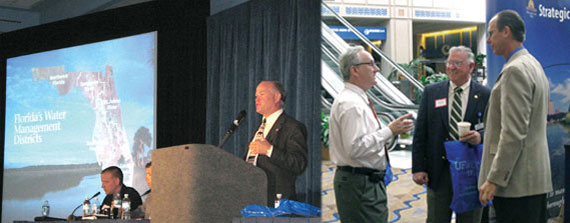 Photo left: David Moore, District executive director, discusses regulatory incentives at the Tampa Bay Water workshop.Photo right: Todd Pressman, Governing Board chair, and Ron Oakley, vice chair, talk with Bart Weiss, Hillsborough County Water Resource Team administrator, before the Tampa Bay Water workshop.
Photo left: David Moore, District executive director, discusses regulatory incentives at the Tampa Bay Water workshop.Photo right: Todd Pressman, Governing Board chair, and Ron Oakley, vice chair, talk with Bart Weiss, Hillsborough County Water Resource Team administrator, before the Tampa Bay Water workshop.
The Peace River Manasota Regional Water Supply Authority (PRMRWSA) and Tampa Bay Water (TBW) recently met with local governments within their regions to discuss how water conservation and alternative water supply sources can help address the region’;s water needs.
Both water conservation summits were held after the Governing Board directed the regional water suppliers to work with the local governments to address the regional water shortage issues.
Peace River Manasota Regional Water Supply Authority
The goal of the PRMRWSA summit was to develop a regional consensus on priorities for long-term water conservation policies and initiatives. Participants were asked to rank their priorities after presentations by:
- Shannon Staub, Sarasota County commissioner and Water Congress delegate, on the Water Congress priority recommendations
- David Moore, District executive director, on regulatory water conservation incentives
- Lou Kavouras, District deputy executive director, on the District’s Florida Water Star Gold water conservation program for new home construction
- Dr. Jim Heaney, professor and chair of the University of Florida’s Department of Environmental Engineering Sciences, on Conserve Florida Water
- Stephen Suau, facilitator with Progressive Water Resources, on the PRMRWSA’s strategic plan for 2025 and EPA WaterSense
One of the top two priorities selected by participants is having local governments compare the costs of constructing new water supply sources and the cost of implementing conservation programs, as well as the quantifiable benefits these investments would offer.
The other top priority is having each municipality document its water savings every 5, 10 and 20 years, as well as estimating the financial savings associated with the water savings.
Participants agreed to focus on these two priorities during the next 12 to 24 months.
In addition, summit participants agreed to continue their individual, effective water conservation programs. But to implement the priority policy recommendations, the PRMRWSA should develop a work plan to ensure consistent water conservation evaluations and reporting.
Tampa Bay Water
More than 100 elected officials, utility and government staff, District personnel and interested citizens attended Tampa Bay Water’s Regional Water Shortage Management Workshop, which examined several water shortage-related topics, including:
- Importance of conservation
- Climate trends
- Diversity of Tampa Bay Water’s supply
- Drought surcharges
- Florida-friendly landscaping
- Technology improvements such as soil moisture sensors and evaporation-transpiration controllers
- Low impact development
“Conservation is a key to long-term sustainability. It’s readily available, it’s the least expensive and it’s the most environmentally friendly of the potential water supplies,” said David Moore, District executive director.
Conservation provides benefits in water savings, but it can also reduce income to utilities. Anthony Hairston, a Public Resources Management Group managing consultant who specializes in water rates, said drought surcharges can help conserve water and make up for potential lost revenue. A drought surcharge increases the cost for water during a water shortage. It can be designed to primarily affect heavy water users.
“With up to 50 percent of residential water use going to outdoor irrigation, the proper design, construction and maintenance of Florida-friendly landscapes can save water and protect water quality,” said Dr. Terril Nell, the Environmental Horticulture Department chair at the University of Florida/Institute of Food and Agricultural Sciences (IFAS). The District partners with UF/IFAS to provide Florida-friendly landscaping™ education to residents, business owners, homeowners associations, property managers, builders and developers.
Dr. Pierce Jones, who directs the UF/IFAS program for Resource Efficient Communities, urged local governments and water managers to promote low impact developments that use smart irrigation technologies.
“West-central Florida is a subtropical region with no discernible long-term rainfall trends but great year-to-year variability,” said David Zierden, the state climatologist for Florida and a contributing member of the Southeast Climate Consortium. He pointed out that land-use changes can impact local rainfall and stressed the importance of adequately preparing for variability in rainfall.
The variability is evidenced in the three-year drought that has lowered river flows and lake and aquifer levels. The lowered river flows, combined with the emptying of the 15-billion-gallon C.W. Bill Young Regional Reservoir, is putting more pressure on already stressed groundwater sources in the region. Tampa Bay Water said it expects to exceed its permitted groundwater quantities at least until the summer rainfalls return to make up for reductions in available surface water.
